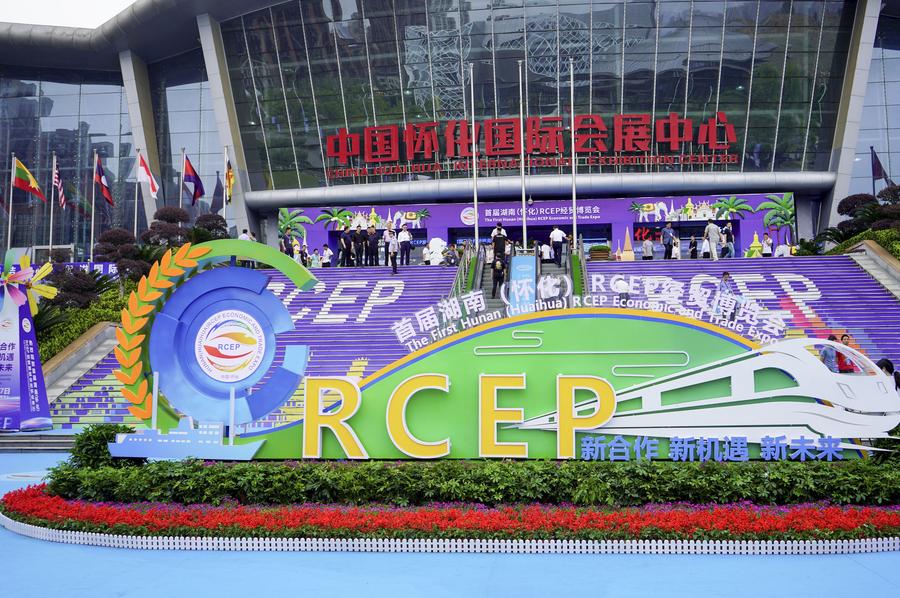China hails trade, investment achievements of RCEP at three-year mark
Source: Xinhua | 2025-01-10 | Editor:Ines

This photo taken on May 5, 2023 shows the venue for the First Hunan (Huaihua) RCEP Economic and Trade Expo in Huaihua City, central China's Hunan Province. (Xinhua/Yu Chunsheng)
The Regional Comprehensive Economic Partnership (RCEP) has deepened trade and investment cooperation among its members since it came into force three years ago, and has effectively consolidated the fundamentals of China's foreign trade, China's Commerce Ministry spokesperson He Yadong said on Thursday.
He made the comments at a regular press conference several days after the third anniversary of the implementation of the RCEP, which fell on Jan. 1 this year.
As the non-ASEAN rotating chair of RCEP in 2024, China worked to facilitate new members in joining the pact, He said, adding that China's Hong Kong, Sri Lanka and Chile have submitted formal applications to join RCEP, while other economies have shown strong interest.
Since it came into force in 2022, the RCEP has helped deepen regional economic integration, He said. In 2023, the trade volume within the RCEP region totaled 5.6 trillion U.S. dollars, and the amount of green-field investment attracted by the region was 2.2 times that of 2021.
From January to November in 2024, China's trade in goods with RCEP members reached 12 trillion yuan (about 1.67 trillion U.S. dollars), an increase of 4.4 percent year on year.
The RCEP is the free-trade agreement with the largest participating population in the world, as well as the largest economic and trade scale, and the greatest development potential, He said.
He added that China, the largest economy in RCEP, will continue to implement the RCEP comprehensively and with high quality, and make greater contributions to promoting Asia-Pacific economic integration and achieving regional common development and prosperity.
The RCEP comprises 15 countries, including 10 countries of the Association of Southeast Asian Nations, as well as China, Japan, the Republic of Korea, Australia and New Zealand.
According to a study conducted by the Asian Development Bank, the RCEP is expected to increase the incomes of member economies by 0.6 percent by 2030, adding 245 billion U.S. dollars annually to regional income and 2.8 million jobs to regional employment.
You May Like
-
Insights | China and New Zealand have many opportunities to ...
Through RCEP and the free trade agreement that New Zealand and China have in place, there are many opportunities for the two countries to explore, said Brett O'...
InKunming 2023-06-30 -
RCEP boosts confidence in trade, regional cooperation
On June 2, the day the Regional Comprehensive Economic Partnership (RCEP) entered into force in the Philippines, Chizhou Customs in east China's Anhui Province ...
InKunming 2023-06-12 -
Extend key linkages for RCEP members
Local governments and friendship cities of the Regional Comprehensive Economic Partnership member countries must speed up steps to boost cooperation in industri...
InKunming 2023-06-10 -
GLOBALink | Philippine officials expect more opportunities a...
The Regional Comprehensive Economic Partnership (RCEP) enters into force for the Philippines on Friday, officially allowing the Southeast Asian country to parti...
InKunming 2023-06-04 -
China's Shenyang opens new freight route for RCEP countries
A train carrying cargo containers from Regional Comprehensive Economic Partnership (RCEP) member countries, including Laos, Vietnam and Japan, departed from the...
InKunming 2023-03-21 -
One year on, RCEP bolsters post-pandemic economic recovery
The Regional Comprehensive Economic Partnership (RCEP) has been a major driver of regional economic growth since its implementation on Jan. 1, 2022.
InKunming 2023-01-17 -
Nearly 7 bln USD of goods benefit from RCEP in Shanghai
More than 48 billion yuan (about 6.9 billion U.S. dollars) of imports and exports under the Regional Comprehensive Economic Partnership (RCEP) free trade agre...
InKunming 2023-01-05 -
Economic Watch: RCEP, a catalyst for recovery, regional inte...
As the world grapples with the COVID-19 pandemic and multiple uncertainties, the implementation of the RCEP trade pact offers a timely boost to faster recovery ...
InKunming 2023-01-03 -
Trade between China, other RCEP members up 7.9 pct in first ...
Trade between China and the other members of the Regional Comprehensive Economic Partnership (RCEP) has sustained rapid growth since the trade agreement took ef...
InKunming 2022-12-30 -
Kunming’s imports and exports to RCEP members reach 43.48 b...
In the first 3 quarters, Kunming’s imports and exports to RCEP members amounted to 43.48 billion, up 68.5 percent year on year.
InKunming 2022-12-01







